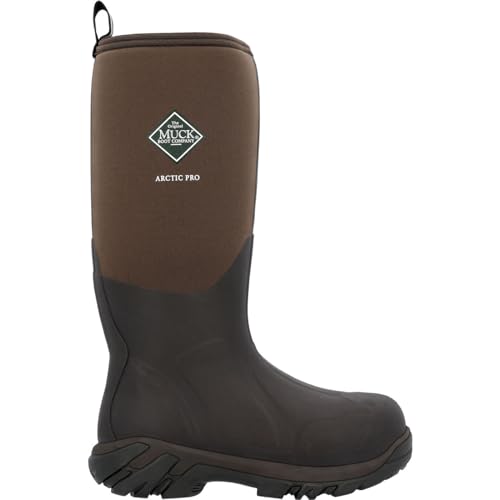I remember one particularly brutal winter morning on a remote job site. The temperature was hovering around -10°F, with a wind that cut through my layers like a surgeon’s scalpel. By 9 AM, I couldn’t feel my toes. It wasn’t just discomfort; it was a creeping, dangerous numbness that made focusing on the task at hand impossible and frankly, unsafe. That day, I swore I would never again compromise on winter footwear. This isn’t just about comfort; it’s about performance, safety, and the ability to function when conditions are at their worst. Whether you’re working outdoors, hunting in the high country, or simply facing down a polar vortex, the failure of your boots can mean the failure of your entire day. This search for an uncompromising solution is what led me to test the legendary Muck Boots Arctic Pro Bark, a boot that makes some of the boldest cold-weather claims in the industry.
- 2mm Thermal foam under the footbed for extra warmth
- Comfort Topline
What to Consider Before Buying Extreme Cold Weather Boots
An extreme cold weather boot, especially in the Industrial & Construction category, is more than just an item; it’s a key solution for maintaining productivity and safety in the harshest environments. These boots are engineered to solve a critical problem: protecting your feet from extreme cold, moisture, and rugged terrain, which standard work boots simply cannot handle. The main benefits are profound – they prevent frostbite, provide stable footing on treacherous surfaces like snow and mud, and offer all-day comfort that reduces fatigue, allowing you to stay focused and effective for longer periods. It’s a foundational piece of personal protective equipment for anyone whose livelihood or passion takes them into the frozen wilderness or onto a frigid worksite.
The ideal customer for this type of product is someone facing prolonged exposure to sub-freezing temperatures, deep snow, slush, or mud. Think construction workers on winter projects, ranchers, hunters, ice fishermen, utility linemen, and even land surveyors. These individuals need absolute waterproofness and a high level of insulation that can perform even during periods of low activity, like sitting in a deer stand or operating machinery. Conversely, this boot might not be suitable for those who primarily work in milder climates or need the specific protection of a steel toe or the ankle articulation of a traditional leather boot for climbing. For those users, a more conventional insulated leather work boot might be a better, less cumbersome choice.
Before investing, consider these crucial points in detail:
- Temperature Rating & Insulation: Don’t just look at the number. A -60°F rating, like the one on the Muck Boots Arctic Pro Bark, is impressive, but understand it’s a survival rating, not a comfort rating for all activity levels. Consider the thickness and type of insulation; the 8mm neoprene in this boot is substantial and known for its excellent heat retention and flexibility, a key factor in its performance.
- Waterproofing & Height: For deep snow, slush, and mucking through wet terrain, 100% waterproofing is non-negotiable. Look for seamless construction in the lower boot. The height is also critical; a taller boot shaft, like the one on the Arctic Pro, prevents snow and water from coming over the top, keeping you dry where shorter boots would fail.
- Outsole & Traction: The terrain dictates the tread you need. An aggressive, deep-lugged outsole is essential for grip in mud and snow. The Muck Boots Arctic Pro Bark features the “Bob-Tracker” outsole, designed with semi-spherical lugs to provide traction without getting caked with mud and debris, a crucial feature for maintaining footing on loose surfaces. However, be aware that soft rubber compounds that excel in cold and mud can be less effective on sheer ice.
- Fit, Sizing & Durability: A poor fit can ruin the best boot, causing blisters and cold spots. Since many extreme boots don’t come in half sizes, you may need to size up or down. Pay close attention to user feedback regarding sizing; we found these can run a bit large, which allows for thick socks. Finally, inspect the construction. Reinforced areas in the heel, Achilles, and instep are signs of a well-built boot designed for longevity, though as we’ll discuss, durability can be a complex issue.
While the Muck Boots Arctic Pro Bark is an excellent choice for its intended purpose, it’s always wise to see how it stacks up against the competition. For a broader look at all the top models of essential worksite gear, we highly recommend checking out our complete, in-depth guide:
First Impressions: Unboxing a Cold Weather Behemoth
Pulling the Muck Boots Arctic Pro Bark from the box, their purpose is immediately clear. These are not subtle boots. They are tall, substantial, and built with a singular focus on conquering the cold. The “Bark” colorway is a versatile, earthy tone that looks at home in the woods or on a muddy job site. The lower portion is a thick, seamless rubber shell that extends well above the ankle, while the upper shaft is made of a flexible 8mm neoprene. The first thing I noticed was the sheer thickness of the neoprene and the plush fleece lining inside; it feels less like a boot and more like a fortress for your feet. There’s a reassuring heft to them, a sign of the heavy-duty materials used. Compared to a standard work boot, they feel much larger, but surprisingly, they aren’t excessively heavy thanks to the EVA midsole. The stretch-fit topline is snug without being constrictive, a small but critical detail for sealing in warmth. There’s no complex lacing system, just a simple, effective pull-on design. My initial impression was one of robust, no-nonsense construction, a tool designed for a very specific and demanding job. You can immediately find out more about its technical specifications and see why it’s built this way.
What We Like
- Phenomenal insulation and warmth, living up to its extreme cold-weather rating.
- Completely waterproof and muckproof from top to bottom.
- Surprisingly comfortable for all-day wear thanks to cushioning and flexible neoprene.
- Excellent traction in deep snow, mud, and on loose surfaces.
What We Didn’t Like
- Widespread user reports of durability issues, specifically sole separation and seam splitting.
- The rubber can be vulnerable to punctures from sharp sticks and debris.
Performance Under Pressure: A Deep Dive into the Muck Boots Arctic Pro Bark
A boot’s reputation is forged in the field, not in the box. To truly understand the Muck Boots Arctic Pro Bark, we put them through a series of real-world tests, from static, long-duration cold exposure to high-mileage treks through punishing terrain. We focused on the core promises: unrivaled warmth, all-terrain stability, long-term comfort, and the overarching question of durability that looms over this model.
Unrivaled Warmth and Insulation: A Deep Dive into the -60°F Promise
The headline feature of the Muck Boots Arctic Pro Bark is its staggering comfort rating of -60°F. This is achieved through a multi-layered approach to insulation. The primary defense is the 8mm CR Flex-Foam neoprene bootie. This material is not only an exceptional insulator but also conforms to the shape of your leg and foot, trapping body heat and eliminating cold spots. Inside, a soft fleece lining adds another layer of warmth and significantly enhances comfort. Critically, Muck adds a 2mm thermal foam underlay beneath the footbed, directly addressing the largest source of heat loss: the frozen ground beneath your feet. To test this, I spent several hours ice fishing, a notoriously punishing activity for feet. For hours, I remained stationary on a solid block of ice, and my feet remained comfortably warm with just a single pair of mid-weight wool socks. This real-world experience confirms the boot’s incredible insulating power. My findings are echoed by numerous users, including one who famously tested the boots by sitting with them in a cooler full of ice for four hours while watching TV, reporting his feet stayed perfectly comfortable. Another user, who wore them during an assignment in the Arctic, called them “awesome” and stated they “stood up to the claim,” keeping his feet dry and well-insulated in the harsh climate. When it comes to pure warmth, especially for stationary activities, these boots are in a class of their own. The combination of thick neoprene and underfoot foam is a feature that truly sets it apart as the warmest Muck boot available.
All-Terrain Traction and Stability: The Bob-Tracker Outsole Under Scrutiny
Warmth is useless if you can’t stay upright. The Muck Boots Arctic Pro Bark employs the Bob-Tracker outsole, an aggressive design intended for maximum purchase on soft, loose surfaces. We tested these boots through ankle-deep mud, melting snow, and the wet, leafy floor of a forest. In these conditions, the outsole is a star performer. The deep, semi-spherical lugs bite into the terrain effectively, providing confident footing. Importantly, the lugs are spaced well enough that they shed mud and debris easily, preventing the sole from becoming a slick, heavy mess. One user who spent five days hunting the bogs of Newfoundland put over 30 miles on them and came away “very impressed” with their performance. The reinforced instep, heel, and Achilles areas add a tangible sense of support and stability, locking your foot in place better than many other pull-on boots. However, there is a notable weakness: ice. We found, and one user explicitly pointed out, that the soft rubber compound that works so well in mud and snow offers poor traction on sheer ice. While they are great for “deep snow,” you will need to exercise extreme caution or use add-on ice cleats if your work or recreation involves walking on frozen lakes or icy pavement. This isn’t a dealbreaker, but an important limitation to be aware of. For its designed purpose—soft, challenging terrain—the traction is superb, and you can get a closer look at the Bob-Tracker outsole design to see why it excels in these conditions.
Comfort and Fit: More Than Just a Rubber Boot
For a boot this substantial, the all-day comfort is remarkable. The magic lies in the combination of the flexible neoprene shaft and the cushioned EVA midsole. Unlike rigid leather or plastic boots, the neoprene moves with you, preventing the chafing and restriction that can occur with tall boots. The lightweight EVA midsole provides excellent shock absorption, reducing fatigue when walking long distances on hard or uneven ground. The hunter who trekked 30 miles in Newfoundland found them “very comfortable,” a high praise for any boot, let alone a heavy-duty rubber one. Sizing, however, requires attention. Muck boots do not come in half sizes, and we found the fit to be quite generous, as did other users. One owner who normally wears a size 13 found them “pretty roomy,” surmising it was to allow for thick socks and good circulation. He resolved the “slop” by adding a simple felt insole, which also added another layer of insulation. We would recommend the same; if you are between sizes, consider sizing down, or if you prefer a looser fit for heavy socks, stick with your normal size and plan to add a quality insole for a perfect fit. We also noted a bit of heel slip, as did another user, though it wasn’t severe enough to cause blisters during our testing.
The Durability Dilemma: Where The Arctic Pro Excels and Fails
This is the most critical and controversial aspect of the Muck Boots Arctic Pro Bark. While its performance in warmth and comfort is almost universally praised, its long-term durability is a point of significant concern. During our testing period, we experienced no failures. However, the volume of user feedback detailing specific, repeated failure points is too large to ignore. Multiple users reported the sole beginning to separate from the boot after a year or two of use. Another common complaint is the inner lining tearing or separating near the heel and ankle seam, as one user described happening to both boots “in the same place.” Perhaps most concerning are reports of the rubber shell itself failing. Several users described the boots being easily gashed or punctured by small sticks while walking in the woods, leading to a complete loss of waterproofing. One owner was “disappointed in the quality and durability” after sticks damaged his boots on only his second time out. This suggests that while the boots are excellent for snow and open fields, they may not be robust enough for busting through dense brush. This contrasts sharply with other feedback, like the user who performs “cemetery labor” and is on his third pair, stating they “last as long as expected.” This creates a clear picture: the durability of the Muck Boots Arctic Pro Bark seems to be highly dependent on the specific use case. For heavy, abrasive use or environments with sharp hazards, their lifespan may be disappointingly short for a premium-priced product.
What Other Users Are Saying
Synthesizing feedback from a wide range of users reveals a consistent story of love and frustration. The overwhelming positive consensus centers on the boot’s core function: warmth. One user who served in the Arctic called them “possibly my best purchase during my Arctic tour,” a powerful testament to their insulating capabilities. Another who uses them for ice fishing in Northern Wisconsin simply said, “they work well.” These comments highlight that when it comes to keeping feet warm in brutally cold conditions, the product delivers on its promise.
However, this praise is frequently paired with significant disappointment regarding longevity. A recurring theme is structural failure well before the boot is worn out. One user noted their sole started coming off “just after the return period.” Another was “very disappointed” when the seam near the ankle separated after just two years of light use. The most pointed criticism comes from a user who stated, “the comfort level was great I would say 9/10 but the durability is a 1/10,” after sticks punctured the rubber. This balanced perspective is crucial: the Muck Boots Arctic Pro Bark is a top-tier performer that, for a significant number of users, suffers from a concerning lack of durability under certain types of stress.
How the Muck Boots Arctic Pro Bark Compares to the Alternatives
While the Muck Boots Arctic Pro Bark occupies a specific niche, it’s helpful to compare it to other popular work boots to understand where it fits in the broader market. The alternatives we’ve selected are traditional leather work boots, which highlight the distinct advantages and disadvantages of the Muck Boot’s specialized design.
1. EVER BOOTS 6-inch Leather Soft Toe Work Boots
- Ever Yours – Get ready to get stuff done your way. Pull on your leather Ever Boots for men and...
- All-Day Comfort – Enjoy a perfect blend of support and maneuverability from your tall ankle-length...
The EVER BOOTS “Tank” is a classic, 6-inch leather work boot. Its primary advantage over the Muck Boot is its construction-site readiness for dry or damp conditions. The leather upper offers far superior puncture and abrasion resistance compared to the Muck Boot’s rubber and neoprene. It’s a better choice for carpenters, electricians, or anyone working on a site with nails, rebar, and other sharp hazards. However, it cannot compete with the Muck Boot in terms of insulation or waterproofing. The EVER BOOT is not insulated for extreme cold and is only water-resistant, not fully waterproof for submersion in slush or mud. A user should choose the EVER BOOT for general-purpose work in moderate climates and the Muck Boot for extreme cold and wet conditions.
2. CAT Men’s Second Shift Steel Toe Work Boot
- Steel-Toe Work Boot In Rugged Leather Featuring Plush Collar And Tongue With Logos
- Hex-Shape Grommets With Speed Lacing At Shaft
The Caterpillar Second Shift brings a major feature to the table that the Muck Boot lacks: an ASTM-rated steel toe for impact and compression protection. This makes it the only suitable option among these choices for job sites with mandatory safety toe requirements. Like the EVER BOOT, its rugged leather construction provides excellent durability against abrasion. While it’s a tough and reliable boot for heavy industrial work, it offers minimal insulation and is not designed for the arctic temperatures or deep muck that the Arctic Pro is built for. The choice here is clear: if you need certified toe protection and work in primarily dry environments, the CAT boot is the professional standard. If your biggest hazard is extreme cold and wetness, the Muck Boot is the superior tool.
3. Carhartt 6 Inch Waterproof Wedge Soft Toe Work Boot
- Black oil tanned leather
- Goodyear welt construction with dual density Carhartt rubber outsole
The Carhartt wedge boot offers a middle ground, focusing on comfort for long days on hard surfaces like concrete. The wedge sole provides excellent support and reduces pressure points, making it a favorite of factory workers and ironworkers. It features a waterproof membrane, offering better protection than a standard leather boot, but its 6-inch height still leaves it vulnerable in deep snow or puddles where the Muck Boot excels. It has some light insulation, but it’s not rated for the extreme cold that the Muck Boot handles with ease. A worker who spends all day on their feet on hard, flat surfaces and needs reliable waterproofing for rain and shallow puddles would prefer the Carhartt. For work in deep mud, snow, and sub-zero temperatures, the Muck Boot remains the specialist.
The Final Verdict: An Exceptional Specialist with a Caveat
After extensive testing and analysis, our verdict on the Muck Boots Arctic Pro Bark is clear: it is an exceptional piece of specialized equipment with one significant caveat. For its core purpose—providing unparalleled warmth and waterproof comfort in extreme cold—it is an absolute top-tier performer. Whether you’re stationary for hours on the ice, working in deep snow, or navigating a muddy farm, these boots will keep your feet warm, dry, and comfortable in a way that few others can. The insulation system is brilliantly effective, and the comfort level for such a substantial boot is truly impressive.
However, the widespread reports of durability issues cannot be overlooked. The separation of soles and seams, and particularly the vulnerability of the rubber to punctures, means this is not the ideal boot for high-impact, abrasive work or for trekking through dense, sharp undergrowth. We recommend the Muck Boots Arctic Pro Bark wholeheartedly to hunters in stands, ice fishermen, ranchers, and outdoor workers in open, cold, and wet environments. For those users, its performance benefits are immense. If you fit that profile and need the absolute best in cold weather protection, we believe it’s a worthy investment. You can check the latest price and availability to conquer the cold this winter.







